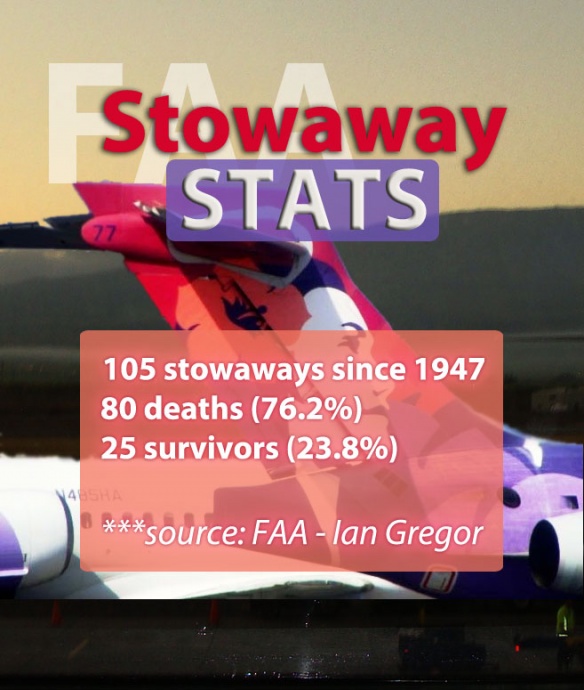FAA: 105 Stowaway Attempts Since 1947, 80 Were Fatal
By Wendy Osher
An investigation continues into Sunday’s stowaway incident in which a teenager survived a nearly 5 ½ hour flight to Kahului, Maui in the wheel well of a plane.
The 15-year-old (age updated by FBI) California boy arrived aboard a Hawaiian Airlines flight from San Jose to Maui on Sunday morning, April 20, 2014. He has since been released to the State of Hawaiʻi, and is in the care of the department’s Child Welfare Services Branch.
Officials with the Department of Human Services say the boy is resting comfortably at a local hospital. Department officials issued a statement today saying they continue to work with the appropriate agencies to ensure the youth’s safe return to his home in California.
Federal Aviation Administration officials tell us that since 1947, there have been 105 people who have stowed away in 94 flights worldwide. Of those, 80 individuals or 76.2% died and 25 people or 23.8% survived, according to Ian Gregor of the FAA.
The last known survivor prior to Sunday’s incident was a stowaway on a domestic flight in Nigeria, Africa in August of 2013.
The last stowaway fatality was at Dulles International Airport in February 2014. That flight had traveled from Johannesburg, South Africa on Feb. 12, 2014 and then on to Dakkar, Senegal, and landed at Dulles on Feb. 14, 2014.
According to an FAA “Research and Development Annual Review” that recapped operations in 2011, federal officials say that prior to 2010, the last stowaway originating from a US airport occurred in 1972, “thus, TSA efforts were successful until the sad case of the young boy from Charlotte, North Caroline, who was killed in his attempt to stowaway in the wheel well of a flight to Boston, Massachusetts, in 2010.”
Federal officials say the incident, “highlighted the ongoing need to review perimeter security at airports to deter such desperate attempts.”
The same report notes that the first recorded case in history of an aircraft stowaway occurred June 13, 1929.
“The Bernard monoplane Oiseau Canari, piloted by Frenchmen Assollant, Lefevre, and Lotti, had trouble taking off in spite of its powerful Hispano Suiza engine. The crew later discovered the cause of the problem: a stowaway on board, a young American, Arthur Shreiber. Despite the overload, the plane landed in Spain after 22 hours of flight over 2,410 miles, setting many records: a first for France over the North Atlantic, the longest flight over the ocean, and the first stowaway in air history.”
The report notes that stowaways face “dangerous situations and risk death,” including the possibility of being crushed when gears retract, falling upon landing, or dying from heat produced by the aircraft engines.
According to the FAA, “death from hypothermia, caused by the extreme cold at high altitudes, or hypoxia, has also been documented.”
The FAA report states that a case in 1993 involving a young Colombian who stowed away in the wheel well of a plane prompted further review of wheel-well stowaways.
In the report, federal officials said that, “however unlikely, based on what we know about human physiology, survival as a wheel-well stowaway is possible.”
The report cited a stowaway case from Tahiti in 2000, in which authorities say the individual’s rectal temperature in the emergency room “was lower than any temperature associated with survival by 6° F.”
At the time, federal authorities said monitoring and assessing stowaway cases offers valuable insight, the most important of which was potential weaknesses in airport security.











